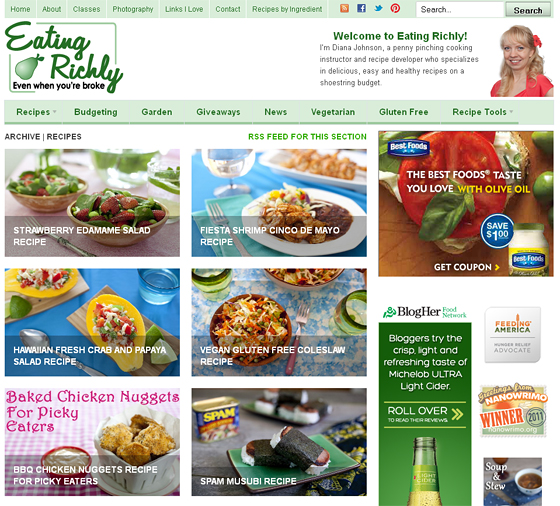She caught up with Bay Area Bites during the two-day event.
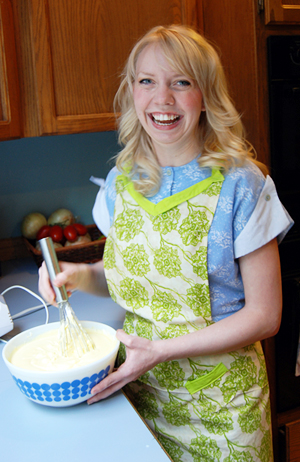
Diana Johnson helps the hungry cook cheaply and eat well. Photo: Heather Johnson
Hunger is really personal for you. Can you tell us about that?
It all started when I lost my job suddenly during 2001, right after September 11. I worked in the tourism industry; I was a dancer on cruise ships and in hotels. All of a sudden, I did not have money for food. One month I literally only had a loaf of bread and a jar of peanut butter for the whole month. There were some days when I was so hungry.
I was a volunteer doing musical theater at the time and nobody knew. It was hard to go out and try to look for jobs and present myself when I was living in my car and I was weak and exhausted. Fortunately, I was living in Hawaii at the time, so I could shower at the beach. It was really easy to hide it.
What happened next?
I got a part-time job at Starbucks and after I got my first paycheck I was able to find a teeny tiny apartment. It was actually a storage shed that had been turned into an apartment by adding a toilet and a refrigerator. Once I paid my rent, my cell phone bill, and electricity for the month I only had one or two dollars a day for food.
That was when I started living off the Dollar Menu at Jack in the Box. I would have a chicken sandwich every morning on my way to work and then if I felt I could spare another dollar I'd have two tacos for dinner in the evening. And I ate that way for over a year.
Did you find yourself getting creative about where to find free food?
I did. Fortunately in Hawaii there are a lot of fruit trees. My church had grapefruit and lychee trees. I knew all the different places around where there were trees I could pick fruit. I had friends who would say let's go out to eat and I would come just to tag along and say I wasn't really hungry and they'd let me finish up food they couldn't eat. That was also part of the reason I kept doing musical theater: We had potlucks all the time. And I was very blessed to have families in my church who would have me over for dinner.
What turned things around for you on the food front?
It was when a friend gave me a bag of groceries -- she knew me well enough to know I was struggling, although I don't think she knew just how much I was struggling -- and she also knew me well enough that she didn't just give me a bag of groceries. She said she and her husband had gone to the store on the same day and didn't realize it so they had extra food. She didn't want me to feel embarrassed.
I still remember what was in it: There were two cans of Dole pineapple, bell peppers, cans of beans, soy sauce, and much more. I wrote it all down, it's on my site. I was able to cook for myself for a week.
I felt so much better that week when I was eating real food instead of fast food. And that's when the light bulb went on for me: What if I take my $7-10 dollars a week to the grocery store? And so I became kind of a student of the grocery store, trying to figure out how to stretch my money, especially in a place like Hawaii, which is astronomically expensive.
I signed up for every free club card. At Starbucks, when people would throw out their newspapers, I would fish them out of the bin and search for coupons. I would look at all the discard bins in the store where they put things on sale because they're dented or about to expire and shop there.
This was the start of my journey learning to cook by using what I had or what was on sale. i had a lot of failures: The worst one was when I tried to use the buttermilk ranch dressing from Jack in the Box with ramen noodles and peas to try to make some kind of pasta. It was terrible.
But I also had some really great successes, like using the same ramen noodles with some soy sauce packets from a local sushi place -- I couldn't afford sushi but I would go in and take their soy sauce packets and honey packets from a fast food place -- and I used that to make something like a teriyaki sauce. And I'd toss that with some frozen or canned vegetables in a stir fry, maybe with some Spam (Spam is really big in Hawaii). I started with really bare bones stuff.
Then I learned how to slowly build a pantry. For example, if I only spent $7 one week, and was able to save $3, I'd have enough to buy a big bottle of soy sauce.
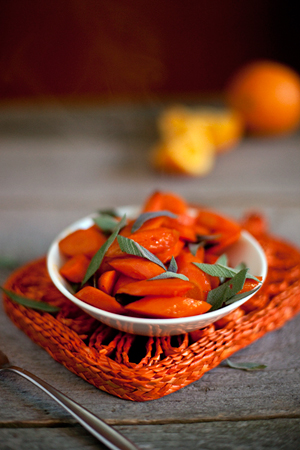
Johnson focuses on whole foods that nourish like this dish for Orange Maple Carrots. Photo: Diana Johnson
Did your parents know?
My parents didn't know a lot of what was going on. After reading about it on my blog, my mom did let on that when she came out to visit back then she was very concerned. She told my dad that I was malnourished: She could just see it in my skin, eyes, and hair.
But I wouldn't have taken their help. At the time we didn't have a good relationship. I was running away from hurts in my life and still hadn't gotten to a place of self-acceptance to be able to then figure out how I fit with the rest of my family.
Why did you start blogging about eating on a budget?
My husband Eric and I met in Washington at church when I was visiting for my sister's college graduation. Three months after I moved there in 2006 we started dating. We actually got married a year to the day after our first date. He would ask me to cook things over again and because I didn't follow recipes, I would type them up on my personal blog -- I called it Dianasaur Dishes -- just so I could keep track of things. I would often put how we saved money on a recipe because we were still on a tight budget -- we made $12,000 between us for the first year we were married. We had about $100 a month for food.
Why did you change the name of your blog recently?
I chose Eating Richly because I wanted to focus on foods that are rich in both nutrients and flavor. I made the shift a few months ago. Dianasaur Dishes was just for me. But when people started telling me how helpful it was I realized that my blog wasn't just for me, it was for others too, and I really wanted to have a title that better described what the blog does.
Eric and I decided it was something we wanted to work on together as well. Dianasaur Dishes was mine. Eating Richly is ours. That's really important to me. He jokes he's the CTO: Chief technical officer. He's also my chief recipe tester and dish washer. And he also does videos: We shoot them together and he edits them.
Do you still cook on a budget at home and how do you cook now?
We're still very frugal: Yes, we're both earning and between the two of us, we were able to buy a house -- a foreclosure -- but money is still tight. We also host two exchange students -- they're teenage boys, they eat a lot -- so for the four of us we budget $400 a month on groceries.
I make most things from scratch now. I still have a few short-cut items that I'll buy like frozen ravioli -- the kind that are healthy, all natural, and ingredients that I recognize. Sometimes I'll get home and we've had stir fry three times in a row, (it's my go-to 15-minute meal), so we'll boil a pot of water and throw in some ravioli. We like very simple foods. We make lots of frittatas, omelets and salads. We eat sandwiches for lunch almost every day, we slice our own lunch meal--roast beef or turkey breast. I make my own mustard and pickles. I grind my own flour for cookies and pizza dough but i have not learned to bake my own bread well yet.
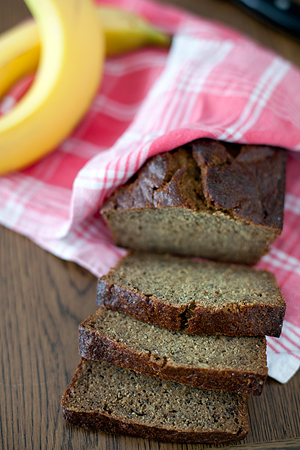
Johnson's version of Healthy Banana Bread. Photo: Diana Johnson
What have you learned about working with the hungry for four years?
The biggest thing I've learned, in the program I created called Healthy Cooking on a Tight Budget, is something I should have known from my own experience: Hunger is not recognizable. You can be in a room full of people and not know that a tenth of them are struggling with hunger. Recently, at a food bank in my area, a doctor who had just lost his practice because of the economy came in because he didn't have money for food. Hunger is humbling for everyone.
Any myths about the hungry you'd like to debunk?
I don't think the stereotypes around hunger are always accurate. Some people think that those who are hungry are homeless or have made poor choices and that's why they're hungry. But there are so many people who are hungry from losing a job or getting injured and being unable to work or just because of circumstances like a death in the family. You just never know. It could be your neighbor, it could be your third grade teacher, or it could be you.
What are some of the challenges helping hungry people?
Some food banks have the mindset that we just need to get food to people, no matter what its nutritional value. That's something that I run into regularly. One of the food banks I teach classes at gives away giant platters of donated cakes to kids and families.
What really makes me sad is a lot of these people are taking the bus or walking to the food bank so they get their bag of groceries, and there are bags with apples, onions, and potatoes, and these huge trays of cupcakes. If they can't carry it all home they tend to leave the bag of apples and carry the cupcakes.
Sometimes it can just get discouraging and tiring -- there's so much need out there -- and sometimes people don't know what to do with basic staples like dried beans, rice, or plain yogurt. I'm creating specific recipes for these items that can just get stuck in the bag that goes home so people have some ideas about what to do with the ingredients they get.
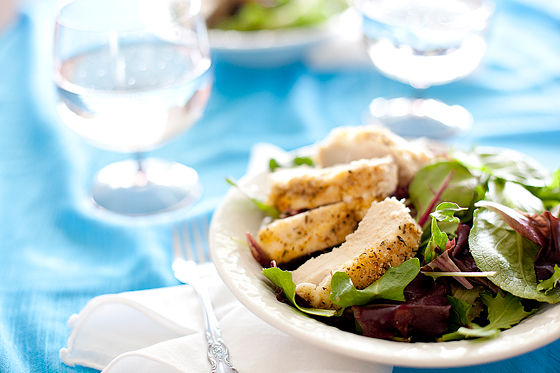
The recipe developer focuses on simple, nutritious dishes that taste good too. Photo: Diana Johnson
What's rewarding about what you do in your community cooking classes?
I enjoy hearing people's stories and seeing them have that light bulb moment like I had when I got that bag of groceries. Every time there are new people in my classes I want them to know I'm not just some foodie coming in and telling them what to do. It helps to share my story. I've talked with food bloggers who can't believe that some people don't make everything from scratch.
